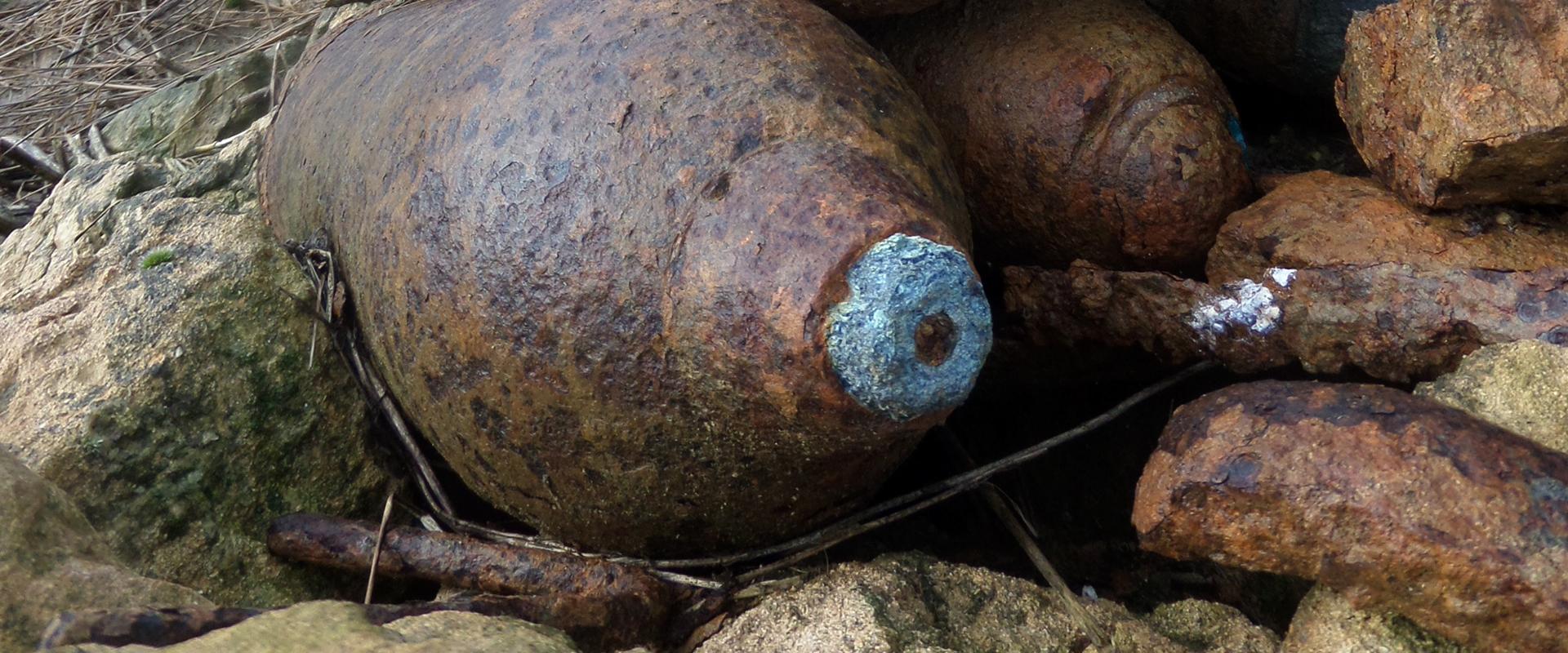Wartime pollution stems from intense destruction caused by powerful weapons, bombing of industrial facilities and chemical spillage from holes left by gunfire.
Little is known about direct contamination from weapons. The poisoning of civilians and military personnel by depleted uranium – a dense, pyrophoric metal used in armour-piercing projectiles – is the only topic that has been studied. These projectiles are currently being inventoried in Ukraine by international mine action authorities.
Unexploded ordnance poses a long-term threat
The clean-up of former battlefields, clearing of explosive remnants of war and abandoned ordnance will be an even greater concern after the war ends.
Some munitions inevitably fail to explode, and depending on the trajectory on impact and type of ground, these projectiles either bounce off or penetrate it. Unexploded devices cause pyrotechnic pollution of soils. They pose a lasting threat to the local population and hamper safe recovery and reconstruction work.
Ukraine has been mined for a long time
This issue is not new in Ukraine: in 2014, it was ranked as the country worst affected by mines, ahead of Syria.
From 1993, two years after the collapse of the Soviet Union, conventional ammunition was added to the list of weapons to be dismantled in Ukraine, the Russian Federation and the new post-Soviet states. The Ukrainian armed forces then inherited significant quantities of ammunition, as well as weapons that were redeployed on their territory following the withdrawal of Russian troops from the former Warsaw Pact states. This led to an accumulation of huge ammunition stocks in the country.
At the end of 2004, the official ammunition stockpile stood at around 2.5 million tonnes. It is estimated that 174,000 km2 of land has been made dangerous by the presence of this ammunition.
A special NATO trust fund for a demilitarisation framework project was therefore set up. The second phase of the project was launched in 2011. This operation was led by the United States, but other countries and international organisations also provided financial and operational support. More than 29,600 tonnes of ammunition and 2.4 million anti-personnel mines have since been cleared.
Ukraine’s future challenge
The development of a strategy to clear Ukrainian soils of surplus ammunition has become a priority, made more urgent by the proliferation of weapons and contamination of soils by unexploded ordnance, mines and projectiles since 2014.
This is a huge challenge, and a lot is at stake, including economically, both inside and outside Ukraine. The fighting and subsequent land contamination are undermining the harvesting of crops on the most fertile lands in the world and disrupting wheat and oilseed markets worldwide.
When the guns fall silent, handling the post-conflict situation will be another hurdle that Ukraine has to face. As the German chemist Karlheinz Lohs wrote in 1991, “war does not end on the day the last shot is fired,” and history teaches us that going to war is easier than coming out of it.
Dam destroyed in Ukraine: a look back at an old military tactic
The destruction of the Kakhovka dam on the Dnipro river on 6 June 2023 flooded an area of over 600 km2 in southern Ukraine, on both the right bank (controlled by the Ukrainians) and the left bank (occupied by the Russians).
18 billion m3 of water poured into the Kherson region, recently recaptured by the Ukrainians, forcing the evacuation of thousands of residents. For both sides in the war, the river is now an obstacle to any attempt at an offensive or crossing.
The war in Ukraine has brought an old military tactic back to the fore: artificial flooding. In the past, water has been deliberately used by the military to protect themselves, create obstacles and/or hinder the manoeuvres of their adversaries.
A Belgian military tradition
In August 1914, in line with the Schlieffen plan, German troops in Belgium made lightning progress. How could the westward progress of the German onslaught be stopped? Despite the element of surprise, the Belgian army resisted. The Belgians then had an idea drawn from the history of their country: deliberate flooding for military purposes in Flanders.
This ploy helped Louis XIV to victory in 1647, 1658 and 1677. In the same way, the Belgian town of Nieuwpoort withstood a five-year siege by the French during the War of the Austrian Succession and protected itself from the Revolutionary Army in 1793.
After some hesitation, despite their knowledge that salination by seawater would destroy the fertility of the submerged agricultural soils for years to come, the Belgians finally opened the sluice gates on the Yser River at Nieuwpoort between 21 and 30 October 1914. In this way, they caused water from the North Sea to flood part of the polder.







